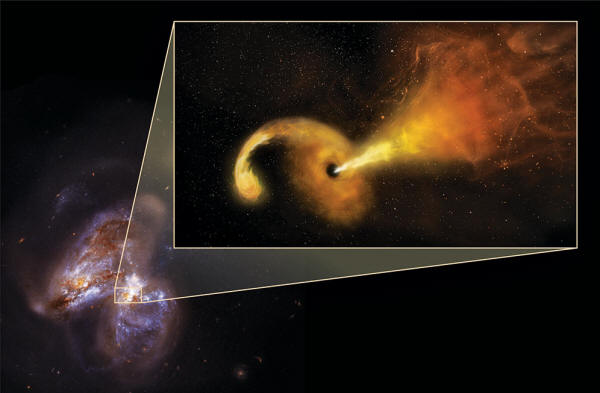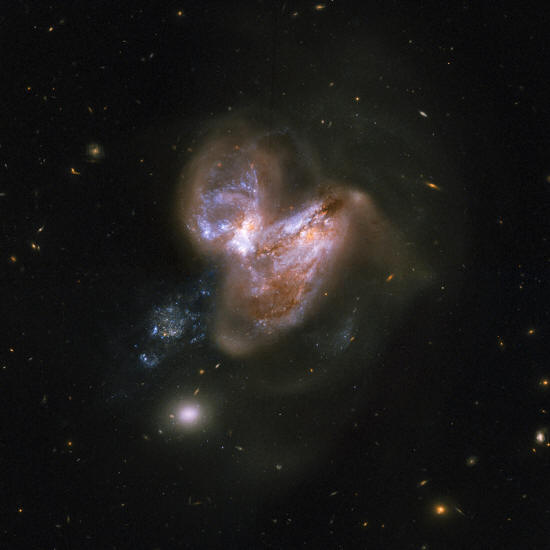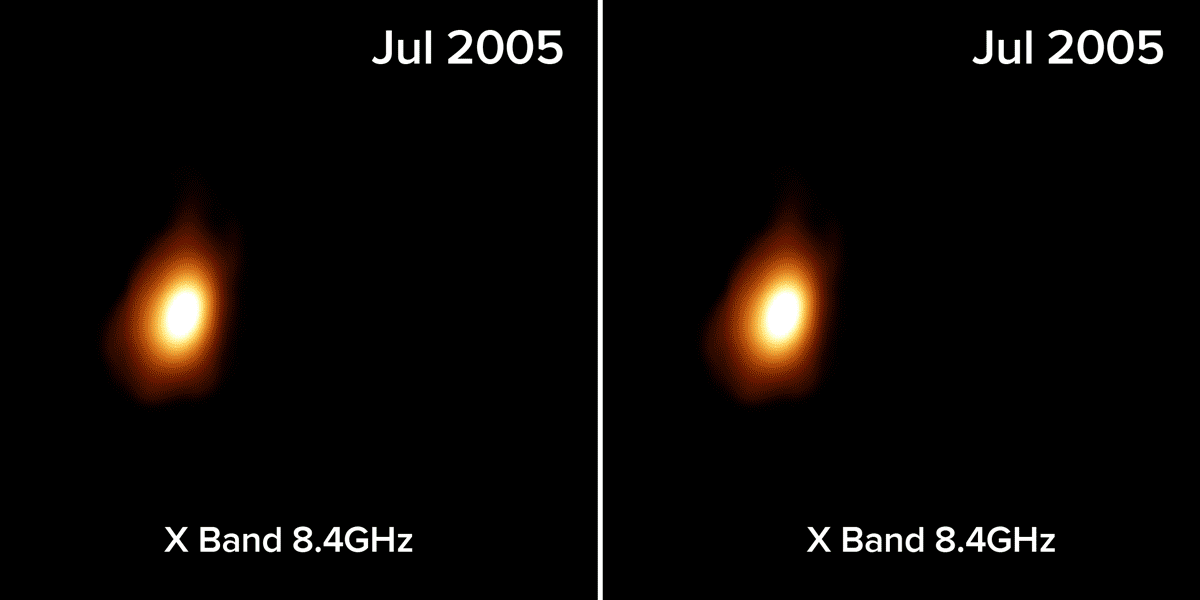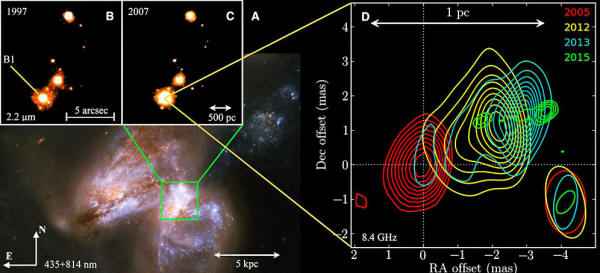|

by Charles Q. Choi
June 14,
2018
from
Space Website

In the pair of colliding
galaxies
Arp 299,
researchers spotted evidence of a supermassive black
hole shredding a nearby star, pulling its debris
into an orbiting disk and blasting a powerful jet of
particles outward.
The background photo is a view of the colliding
galaxies from the Hubble Space Telescope; an
artist's concept of the black hole system is pulled
out.
Credit: Sophia Dagnello/NRAO/AUI/NSF/NASA/STScI
A dust-enshrouded,
giant black hole ripping apart a
star blasted out a superfast jet of particles that packed about 125
billion times the amount of energy the sun releases per year, a new
study finds.
This is the first time astronomers have directly imaged the
formation and evolution of such a jet from a black hole. This
finding may help astronomers discover many new instances of black
holes destroying stars.
Supermassive black holes that are millions to billions times the
mass of the sun are thought to lurk in the hearts of most, if not
all, large galaxies.
If a star passes too
close to such a monstrous black hole, its powerful gravitational
pull will tear it apart in a so-called tidal disruption event.
As a black hole tears matter off a star, this material forms a
rotating disk that glows brightly before it falls into the black
hole.
Previous research also
suggested that jets of particles are launched outward from the poles
of these so-called accretion disks at extraordinarily high speeds.
Most times, supermassive black holes are not actively devouring
anything, the new study's researchers told Space.com.
The small number of tidal
disruption events that astronomers have detected so far offer
scientists the chance to learn more about the formation and
evolution of these jets.

Arp 299
Wikipedia
The first evidence that researchers had of this newly reported jet
came on Jan. 30, 2005, from astronomers using the William Herschel
Telescope in the Canary Islands to analyze a pair of colliding
galaxies called Arp 299, nearly 150 million light-years from
Earth.
They discovered a bright
outburst of infrared light coming from the core of one of the
colliding galaxies in Arp 299, study co-lead author Seppo Mattila,
of the University of Turku in Finland, told Space.com.
On July 17, 2005, using the Very Long Baseline Array (VLBA)
- a network of 10 radio telescopes spread across thousands of miles
that can work together to essentially act like a giant radio
telescope - scientists detected a new source of radio emissions from
the same location in Arp 299.
"As time passed, the
new object stayed bright at infrared and radio wavelengths, but
not in visible light and X-rays," Mattila said in a statement.
"The most likely
explanation is that thick interstellar gas and dust near the
galaxy's center absorbed the X-rays and visible light, then
re-radiated it as infrared," Mattila said.

This supermassive black hole shredding a star in the
system Arp 299 resulted in an expanding, radio-emitting
region, indicating a jet of particles moving outward.
Credit: Mattila, Perez-Torres, et al;
Bill Saxton/NRAO/AUI/NSF
The researchers initially thought this outburst was a star exploding
in a supernova, but that explanation didn't match the data.
Continued monitoring over
nearly a decade showed the source of radio emissions, dubbed
Arp 299-B AT1, expanding in one direction, just as would be expected
for a jet, but not for a supernova.
Radio data suggested the
material in the jet raced outward at an average of about 25 percent
the speed of light.
In contrast, the average
expansion speed of a supernova after 10 years is expected to be, at
most, about 5 percent of the speed of light, study co-lead author
Miguel Pérez-Torres of the Astrophysical Institute of Andalusia
in Granada, Spain, told Space.com.
"We continued to
patiently collect more and more data to discern the true nature
of this source, and our patience paid off," Mattila said.
"The combination of
our infrared and radio observations, coupled with state-of-the
art simulations of radio jets and calculations of infrared
emission from the dusty regions surrounding a supermassive black
hole, left us with one plausible explanation:
the infrared and
the radio emission came from the disruption of a hapless
star being devoured by the supermassive black hole when it
passed too close to this cosmic monster."
The researchers estimated
that this jet resulted from a supermassive black hole that was 20
million times the mass of the sun.
The black hole was
situated at the core of one of the pair of colliding galaxies and it
was in the act of shredding a star that was more than twice the
sun's mass.
"Never before have we
been able to directly observe the formation and evolution of a
jet from one of these events," Pérez-Torres said in a statement.
The new findings were a
surprise, the scientists said.
Arp 299-B AT1 was
discovered as part of a project that sought to detect supernova
explosions in colliding pairs of galaxies.

The transient Arp 299-B AT1
and its host galaxy Arp 299.
(A) A color-composite optical image from the Hubble
Space Telescope (HST), with high resolution, 12.5 ×
13 arcsecond size near-infrared 2.2 μm images
[insets (B) and (C)] showing the brightening of the
B1 nucleus (7).
(D) The evolution of the radio morphology as imaged
with Very Long Baseline Interferometry (VLBI) at 8.4
GHz (7 × 7 milliarcsecond region centered at the 8.4
GHz peak position in 2005, RA = 11h28m30.9875529s,
Dec = 58°33′40′′.783601 (J2000.0), indicated by the
dotted lines).
The VLBI images are aligned with an astrometric
precision better than 50 μas.
The initially unresolved radio source develops into
a resolved jet structure a few years after the
explosion, with the center of the radio emission
moving westward with time (7).
The radio beam size for each epoch is indicated in
the lower-right corner.
This infrared burst was
originally thought to be a supernova explosion.
It was only in 2011, six
years after the outburst's discovery, that Arp 299-B AT1 began to
show the elongation that went on to reveal that it was a jet and not
a supernova.
Over the course of about a decade, the jet released more than 1.5 x
1052 ergs of energy in infrared and radio waves, the
researchers said. This is about 125 billion times the amount of
energy the sun releases per year.
With the help of the VLBA, now the scientists are,
"witnessing how the
radio source is now breaking up into several separate sources,
telling us how the interaction of the jet with its surrounding
medium is proceeding," Pérez-Torres said.
The event was not bright
in visible or X-ray wavelengths, likely because of the effects of
gas and dust, the scientists noted.
This may help explain why
tidal disruption events are not as bright as theoretically
predicted, they added.
"How many similar
events are we missing in dusty centers of galaxies that would
only be detectable by infrared and radio observations but be
completely invisible in the optical light?" Mattila said.
These new findings
suggest that infrared and radio telescopes may discover many tidal
disruption events that may have escaped detection until now because
dust absorbed any visible light from them, Pérez-Torres said.
Such events may have been
more common in the early universe, so investigating them may help
scientists understand the newborn cosmos, the researchers added.
The scientists detailed their findings (A
Dust-enshrouded Tidal Disruption Event with a Resolved Radio Jet in
a Galaxy Merger) online June 15 in the journal Science.
|





